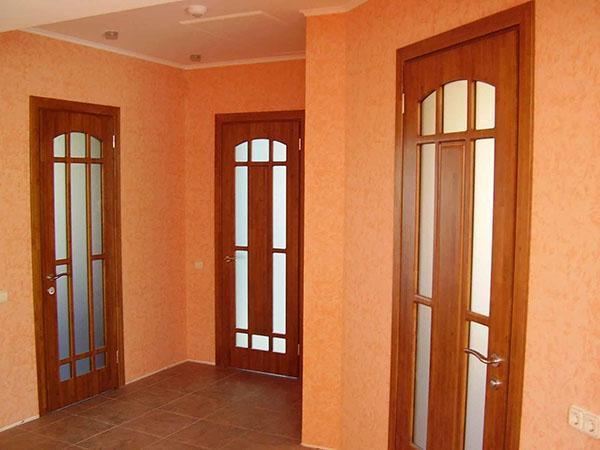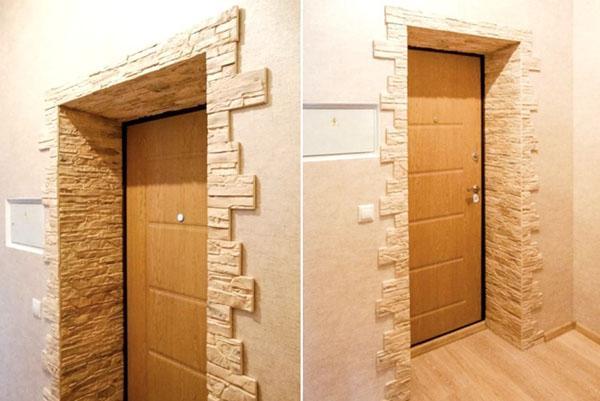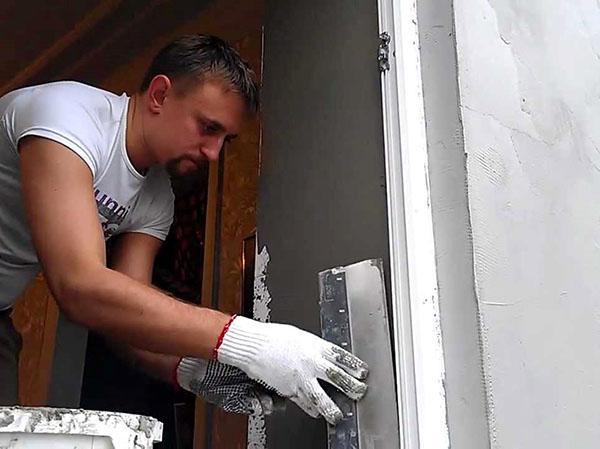How to make slopes for interior doors with your own hands
 During the repair or simply replacing the door, it becomes necessary to install the slopes for the interior doors with your own hands. Modern manufacturers offer a huge variety of materials that can be used to decorate this part of the room. It should be noted that those techniques that are used indoors are not always suitable for use on external slopes or slopes accompanying the entrance doors of the main or emergency (fire) exit. The method should be chosen depending on the design of the room, the ability to perform this or that work and financial capabilities (see: DIY installation of interior doors - step-by-step instructions with a photo).
During the repair or simply replacing the door, it becomes necessary to install the slopes for the interior doors with your own hands. Modern manufacturers offer a huge variety of materials that can be used to decorate this part of the room. It should be noted that those techniques that are used indoors are not always suitable for use on external slopes or slopes accompanying the entrance doors of the main or emergency (fire) exit. The method should be chosen depending on the design of the room, the ability to perform this or that work and financial capabilities (see: DIY installation of interior doors - step-by-step instructions with a photo).
Work options
There are at least a dozen options for how to make slopes for interior doors. Here are just a few of the possible options:
- Installation of drywall sheets.
- Plaster followed by applying a putty.
- Application of decorative plaster.
- Cover panels such as MDF.
- Wood finishing.
- Lining with laminate.
- Installation of chipboard panels.
- Installation of PVC panels.
- Plastic finish.
- Decorating slopes with artificial stone.
- Installation of tiles.

- plaster followed by applying putty;
- installation of overhead panels;
- plastic finishing;
- installation of drywall sheets.
Each of these methods has advantages and disadvantages. What are the pros and cons of these slopes for interior doors is shown in the table below:
| № | Method | Benefits | disadvantages |
| 1 | Plaster followed by applying a putty | It can be used on any slopes, no matter how wide they are. The finish can be varied - wallpaper, paint, and so on. | The work being done is very dirty, besides, it is necessary to own at least the initial filling skills. The curved the slope, the more difficult it is to level it with a putty. It takes time for the layers to dry; finishing requires a large amount of materials and tools. |
| 2 | Installation of cover panels | The work is done quickly, the appearance of the finished slopes is attractive, expensive and beautiful. After installing the panels, there is no need to additionally process the slope. | The panels are expensive. When installing, accuracy and accuracy are important. |
| 3 | Plastic finish | Plastic door slopes are installed quickly, are cheap, and are durable. Plastic is easy to clean. | Work requires precision. Plastic slopes look cheap. |
| 4 | Plasterboard installation | Plasterboard gives a flat surface, it is not difficult to work with drywall. There is a choice of the final design of the slope - painting or wallpapering. | Drywall is unacceptable to use in places of high humidity. |
When the slopes for interior doors are made by hand, you should select the option that is most realistic in performance. Below will be a step-by-step guide for making the slopes with the above options.
The sequence of work with putty
 The amount of work depends on the curvature of the slopes. At the beginning, it is plastered with a cement or starting gypsum mixture, and then putty with a finishing putty.
The amount of work depends on the curvature of the slopes. At the beginning, it is plastered with a cement or starting gypsum mixture, and then putty with a finishing putty.
A primer is required between different layers - it prevents the next layer from flaking.
When making the slopes on the doors with plaster or putty, it is important to protect the adjacent walls, flooring and the doors themselves from the putty mixture. To do this, they must be pasted over with masking tape, stretch film or other protective materials.
The sequence of work performed is as follows:
- The surface is cleaned of all existing contaminants, including dust. Finishing the slopes of interior doors necessarily includes priming, so the cleaned surface is primed.
- The leveling mixture is prepared in a clean bucket. It can be a cement mixture (if the slope is very curved) or starting gypsum. When mixing, pay attention to the manufacturer's recommendations on how and in what proportions to mix the mixture.
- Using a slicker, a rule and a spatula, apply and level the mixture on the slope. Wait until it is completely dry, even if it takes several days.
- This layer is also primed. After that, a finishing gypsum putty is applied to it.
- After the finishing mixture has completely dried, the slope must be sanded using sandpaper numbered 150 to 240.
In this state, the do-it-yourself door jamb is ready for painting or wallpapering.
How do-it-yourself slopes for interior doors are made from plastic
 Choosing plastic for work, you can stop not only on the classic white version. Depending on the color of the room, you can choose colored plastic panels. Moreover, some plastic panels have a pattern like wood, leather or other materials. It looks stylish, fashionable and modern, and in installation such panels do not differ from ordinary ones.
Choosing plastic for work, you can stop not only on the classic white version. Depending on the color of the room, you can choose colored plastic panels. Moreover, some plastic panels have a pattern like wood, leather or other materials. It looks stylish, fashionable and modern, and in installation such panels do not differ from ordinary ones.
To install plastic slopes on the door, you must adhere to the following sequence of actions:
- The surface of the future slope is cleared of all dirt and dust.
- Profile guides are installed on the slope, which look like strips.
- The required size of the parts is measured, for this it is best to use a tape measure.
- The plastic is cut according to the selected size. Whenever possible, when making door slopes with your own hands, it is better to use a jigsaw. If this is not possible, a hacksaw for metal will do.
- First, the side parts are fixed, and then the upper slope is attached.
- The joints of the plastic at the top are treated with a sealant, for example, silicone, matched to the color of the plastic. On the extreme sections, plugs are put on in the form of corners.
After completing all the work, the plastic panels must be washed with a damp cloth, even if they did not get dirty during work. The finished slope will look clean and tidy.
How to veneer a slope with overhead panels
 You can make a slope for interior doors using self-laid overhead panels. Such panels can be MDF panels, PVC panels and others. The preparation of the slopes should be carried out in the same way as with other types of cladding - the surface is cleaned of all dust and dirt. It should be noted that overhead panels are suitable not only for narrow but also for wide slopes. This makes them versatile. Cover panels can be installed on interior slopes without doors.
You can make a slope for interior doors using self-laid overhead panels. Such panels can be MDF panels, PVC panels and others. The preparation of the slopes should be carried out in the same way as with other types of cladding - the surface is cleaned of all dust and dirt. It should be noted that overhead panels are suitable not only for narrow but also for wide slopes. This makes them versatile. Cover panels can be installed on interior slopes without doors.
The order of work is as follows:
- The state of the slope is determined to select the type of attachment. When the slopes are flat, the panels are attached to liquid nails. If the slope is plaster, concrete or brick, the panels are attached to the frame. In this case, the slope on the door is attached to a metal structure. Wooden bars can also serve as a frame.
- The selected frame type is set.
- Parts of the required size are cut from the panels.
- The panels are attached to the frame.
- The corners of the panels are closed with platbands.
- At the joints of the panels, the joints are treated with silicone sealant.
Slope with drywall
 Making door slopes using drywall is a cheap and simple option that does not require much skill. The slope surface immediately becomes level and suitable for further processing. Drywall can be installed on the slopes of doorways in which there will be no doors. Thus, you can make both side and top slopes.
Making door slopes using drywall is a cheap and simple option that does not require much skill. The slope surface immediately becomes level and suitable for further processing. Drywall can be installed on the slopes of doorways in which there will be no doors. Thus, you can make both side and top slopes.
Interior slopes without doors, made in the form of an arch, cannot be finished with plasterboard - it only gives a perfectly flat plane that cannot be bent.
How to do the job with drywall sheets:
- There are several ways to fix drywall. One of the simplest is gluing drywall onto a fugenfüller putty mixture. First you need to measure the slope, its required dimensions. Drywall sheets are cut to fit the finished slope.
- Before gluing, you must attach the cut sheet to the slope to make sure it is the correct size.
- You should work quickly with the fugenfüller, since this putty mixture dries very quickly. It cannot be mixed with a mixer; manual mixing will do.
- Several Fugenfüller spatulas are applied to the prepared piece of drywall, the drywall is applied to the slope and leveled using a square and a level.
- After drying with the fugenfüller, drywall can be either painted immediately or pasted over with wallpaper.
As you can see from the information described in this article, when choosing how to trim the slopes of interior doors, it is possible to choose a wide variety of options. All these options are presented in different price categories, so choosing the one you want is not difficult. This article described the advantages and disadvantages, as well as the sequence of work for the most popular types of finishing the slopes of interior doors, such as:
- plaster followed by applying putty;
- installation of overhead panels;
- plastic finishing;
- installation of drywall sheets on the fugenfüller.
When choosing a method, start not only from the desired result, but also from the availability of the necessary tools and materials to perform this or that type of work and the availability of practical skills from the one who will perform the work (if it is not possible to hire builders to perform the work professionally).